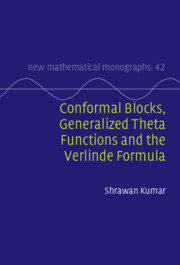Book contents
- Frontmatter
- Contents
- Preface
- Introduction
- 1 An Introduction to Affine Lie Algebras and the Associated Groups
- 2 Space of Vacua and its Propagation
- 3 Factorization Theorem for Space of Vacua
- 4 Fusion Ring and Explicit Verlinde Formula
- 5 Moduli Stack of Quasi-parabolic G-Bundles and its Uniformization
- 6 Parabolic G-Bundles and Equivariant G-Bundles
- 7 Moduli Space of Semistable G-Bundles Over a Smooth Curve
- 8 Identification of the Space of Conformal Blocks with the Space of Generalized Theta Functions
- 9 Picard Group of Moduli Space of G-Bundles
- Appendix A Dynkin Index
- Appendix B C-Space and C-Group Functors
- Appendix C Algebraic Stacks
- Appendix D Rank-Level Duality (A Brief Survey) (by Swarnava Mukhopadhyay)
- Bibliography
- Index
3 - Factorization Theorem for Space of Vacua
Published online by Cambridge University Press: 19 November 2021
- Frontmatter
- Contents
- Preface
- Introduction
- 1 An Introduction to Affine Lie Algebras and the Associated Groups
- 2 Space of Vacua and its Propagation
- 3 Factorization Theorem for Space of Vacua
- 4 Fusion Ring and Explicit Verlinde Formula
- 5 Moduli Stack of Quasi-parabolic G-Bundles and its Uniformization
- 6 Parabolic G-Bundles and Equivariant G-Bundles
- 7 Moduli Space of Semistable G-Bundles Over a Smooth Curve
- 8 Identification of the Space of Conformal Blocks with the Space of Generalized Theta Functions
- 9 Picard Group of Moduli Space of G-Bundles
- Appendix A Dynkin Index
- Appendix B C-Space and C-Group Functors
- Appendix C Algebraic Stacks
- Appendix D Rank-Level Duality (A Brief Survey) (by Swarnava Mukhopadhyay)
- Bibliography
- Index
Summary
The basic Factorization Theorem is proved here, which explicitly relates the space of vacua on an s-pointed curve of genus g with a single node with that of the space of vacua on the normalization (which is of genus g-1) marked with s+2 points. We sheafify the construction of the space of vacua for a family of s-pointed curves and show that it is a coherent sheaf. We further show that this sheaf for a smooth family is locally free and admits a functorial flat projective connection. This connection generalizes the Knizhnik--Zamolodchikov connection for the projective line. Using this, we show that the dimension of the space of vacua does not depend either upon the choice of the holomorphic structure on the curve or on the choice of the marked points on the curve. Using the Factorization Theorem, we prove an inductive formula to calculate the dimension of the space of vacua on a genus-g curve in terms of a genus-(g-1) curve though with s+2 points. Using this successively, we are reduced to calculate the dimension of vacua on a projective line with s+2g points. Using a similar decomposition, the problem further reduces to that for three marked points on the projective line.
Keywords
- Type
- Chapter
- Information
- Publisher: Cambridge University PressPrint publication year: 2021



